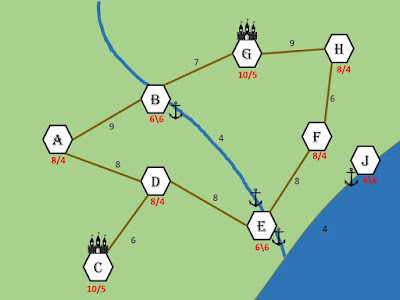In thinking about a solo campaign, I am of a mind that many of the actions that one would want to do in a wargaming (military) campaign should be adjudicated through some stochastic method - a dice chance, or probability chance - of success. This keeps too much mono-thought and knowledge of what the other side (i.e. - the same player - me) is thinking, from creeping into the calculus of what a turn consists of. If every action has to be diced for, then there is necessarily a layer of artificial constraint introduced that will keep actions from always being successful.
Okay, enough philosophy of solo game design. Here is my idea. Have a map, based on point-to-point movement, which is marked up with a number of key pieces of information. Initially, I am thinking that the information would be numbers reflecting the chances of completing a military move, and also of recovering casualties and recruiting new figures. Here is an example of what I am thinking of.
On this map, the hexagons represent campaign locations. The castle symbols represent either cities or fortified areas (the actual symbols used would be based on what time period, and what sorts of locations are important to know about for that time period). The black numbers are the difficult of completing a move along that route. If you decide to try and move an army from location G to location H, for instance, you see that the route has a "9" marked on it. That means, in this simple example, that if you roll 2d6, and score 9 or less, then the move is successful. Sea routes are also marked - notice the score along the river between B and E, and the score along the coast between E and J. The Anchor symbol represents that the location has access to water based movement along the waterway that the anchor is connected to.
So much for movement. But the locations on the map are also marked with pairs of red numbers under each. Those represent two things - the first is the chance to recover troops. This could be a chance to recover lost stands from a unit, after a battle. Again, this is based on a roll of 2d6 or less. The numbers used are purely for example and discussion in this article, but the numbers I used are 8 in regular locations, 10 in population centers (cities), and 6 in ports (or economic centers, but none were marked on this map), where I reasoned that there are more demands for work would mean it is harder to recruit men to serve in a unit. The second number is the chance to recruit a whole unit if it is available to an army to recruit such a unit. Limits could arise from the tactical rules used (i.e. - in some games, and army only consists of a maximum number of units), or could be introduced as part of the campaign (each leader is given an Operations rating, which represents the maximum number of units he may have under his control).
This system could easily be expanded by introducing resources (gold, food, ore, magic, etc) to represent the particular time period. Different types of routes could be introduced (rail lines, which would also have a number representing how difficult it would be to plan a military move over a stretch of rail). By having different routes, different rules on how many different types of moves a unit could make, could be introduced.
That brings me to the last point - action points. I was originally thinking something like 3 action points. It would cost 1 point to move one segment by land, and 1 point to try to recover a lost stand to a unit, but all 3 points to try and recruit a new unit, and maybe 1/2 point to move by a sea route. In this way, if using a 2d6 system to adjudicate actions, then if rolling a 2, one would have a critical success, and would be able to recover an additional action point to use this turn. If rolling a 12, it would mean abysmal failure in planning, and no additional action points may be spent that turn.
Finally, the added element might be characters, or rulers. I always liked the idea, based on the original Tony Bath concept, of having all the major characters in a campaign nation to be developed. This was done in very nice way in the board game Blood Royale, many years ago, and also in many miniatures campaign systems. One of the things by having a dice based campaign system, is that some characters might be better at some actions vs others, not to mention skills at tactical combat (either command bonuses, or combat bonuses). For instance, Lord Whistlebird is a harsh tyrant, but a bit of a coward. He gains a +1 bonus to target numbers when trying to organize a march (he pushes the men into a forced march), but gets no bonus from being in combat with a unit.
Many possibilities are here with even such a simple system. I think I might put together a map, and try it out with the Renaissance troops.

No comments:
Post a Comment